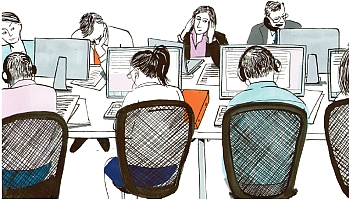When was the last time you gave much thought to your office? Not the people or the location, but the physical space. Some new and rather disturbing trends are starting to emerge south of the border, and this is one time when I’m glad that the legal profession in Canada isn’t leading the pack. But we ought to be wary.
Getting to spend time visiting firms across North America as a result of my new gig has afforded an interesting insight into first impressions — from the choice of office location to reception furniture to the artwork firms choose to display. For a profession considered to be buttoned-down, there are some pretty radical choices out there! So far one of my favorites has been Brouse McDowell in Akron, Ohio, located around a six-storey atrium that gives a view on to the original factory floor of one of the B.F. Goodrich manufacturing complex buildings; a close second is the rather eerie distended head in the lobby of one of the major firms in Calgary.
But at least in the legal profession here we seem so far to have managed to avoid the virus of “open plan” office spaces being inflicted on our professional-services colleagues and those working in publishing.
Even worse, in some places folks are now adopting the idea of “workbenching,” something I blame on Silicon Valley and the ubiquitous “process improvement” consulting firms. Have you heard about this? Think of those horrible cafeteria tables you suppressed in distant high-school memory. Now, bring your laptop and your coffee mug, set yourself up with the cool kids, and start working. No dedicated desk, no pesky paper files, no privacy, and for employers, less need for office rent. The space is supposed to encourage the free flow of ideas and shared problem-solving. The reality? Employees are bringing in headphones, further isolating themselves; The New York Times reported last November that publisher Hachette pipes in “pink noise,” white noise set to the frequencies of human voices, through a system of overhead speakers to deal with the disruptive buzz.
How the heck people are supposed to get anything done in these spaces is beyond me. Anyone I know whose office has been converted into these monstrosities loathes them. One workaround that may also be a sign of the impending revolt: at some offices, each workbench floor has a series of dedicated “collaboration rooms” (i.e., offices with sliding doors) that can be closed to permit quiet discussions and phone calls. These are supposed to be booked hourly and only for meetings, but I know of one instance where almost as soon as they were introduced, each one was fully reserved by the senior managers for the rest of the coming year!

But the importance of the office goes beyond a need for privacy. One New York magazine article in January about the challenges of freelance life quoted a management study by University of Michigan professor Sue Ashford, reporting that “nonstandard workers” had not only economic stress but identity stress: “Like, Who am I? Do I have any value? What was missing was a sense of place.”
Ashford’s collaborator, Adam Grant, concluded that the “physical presence of the office suggests something real. It’s not just that they bring people together. It’s that they’re a stable representation of the organization — the mission and values it represents and the community it’s designed to hold and create. … I think the office is about object permanence. ... It’s a landmark. But in a society as mobile as ours, we run the risk of never having that permanence.”
So here’s to the overhead cost of an office with your name on the door (and, indeed, a door), a photo of people or pets or places that matter to you on the desk (and, indeed, a desk) and maybe a plant. Ignore the kvetching, don’t worry about whether your desk is bigger than the one next to yours, leave the artwork choices to the firm committee, and be grateful. Things could be much, much worse.
Paul Paton is the Wilbur Fee Bowker Professor and Dean of Law at the University of Alberta. He can be reached at [email protected].





